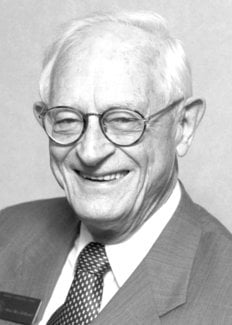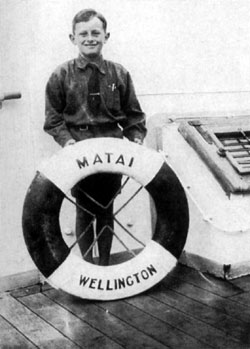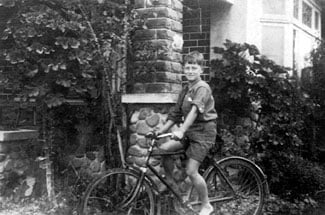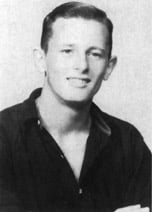Alan MacDiarmid
Biographical
 I was born a Kiwi (a New Zealander) in Masterton, New Zealand on April 14, 1927, and still am a Kiwi by New Zealand law, although I became a naturalized United States citizen many years ago in order to have the right to vote in US elections and, hence, voice my political opinions in a meaningful way. My father, an engineer, was unemployed for four years during the Great Depression which hit New Zealand rather severely in the early 1930s. Since jobs were believed to be more plentiful in the vicinity of Wellington, the capital city of New Zealand, located at the bottom of the North Island, we moved to Lower Hutt a few miles from Wellington. There my two older brothers and my elder sister were able to find jobs while I and my younger sister were still at primary school.
I was born a Kiwi (a New Zealander) in Masterton, New Zealand on April 14, 1927, and still am a Kiwi by New Zealand law, although I became a naturalized United States citizen many years ago in order to have the right to vote in US elections and, hence, voice my political opinions in a meaningful way. My father, an engineer, was unemployed for four years during the Great Depression which hit New Zealand rather severely in the early 1930s. Since jobs were believed to be more plentiful in the vicinity of Wellington, the capital city of New Zealand, located at the bottom of the North Island, we moved to Lower Hutt a few miles from Wellington. There my two older brothers and my elder sister were able to find jobs while I and my younger sister were still at primary school.
My mother and father set the stage for nurturing a warm, loving united, mutually supportive family who always pulled together and also helped others outside the family in need when necessary. Although we did not have too much food, my mother was always inviting other, less fortunate people to meals. On such occasions, my older brothers and sister would frequently remind me and my younger sister at meals not to ask for more food by saying to us out loud at the table, “FHB,” which meant, “Family Hold Back,” i.e., don’t eat too much! We had no phone or refrigerator. In one of the houses we lived in Lower Hutt, our hot water came from water pipes embedded in the brick at the back of the open fireplace in the living room. This resulted in our weekly bath night – where the younger children used the bath water from the older children, to which we were allowed to add more hot water if any still remained! For most of my time at primary school, I went to school barefooted, like most of the other kids. The soles of our feet literally became leather!
Even though I have been away from New Zealand for about 50 years, my brothers and sisters and I (my parents passed on several years ago) are still very closely connected to each other. Throughout the decades we have telephoned each other about every ten days and we all keep up to date with what we are each doing. Shortly after learning of my being a recipient of the Nobel Prize I was speaking to one of my brothers in New Zealand by phone and I said how lucky I was to have been raised in a poor family which was also a close loving family. The fact that we were poor made us self reliant and conscious of the value of money. The fact that we were closely knit taught us the important aspects of interpersonal relationships. Everyone expects “the important things” in life that such as birthday and Christmas presents, but it is the “little unimportant” actions which actually are the real important things. These put the flesh on the skeleton of any relationship. Several hundred of these each week – the unimportant, the unexpected, the unnecessary, “the little things”, are the things that really count. We are lucky to have been brought up in this environment, but there is a statement on the wall of my study at home in suburban Philadelphia which reads, “I am a very lucky person and the harder I work the luckier I seem to be”!
It is my home life while growing up through high school, which I consider to have been the single most important factor in any success which I may have had in life. As my parents always said, “…an ‘A’s grade in a class is not a sign of success.” Success is knowing that you have done your best and have exploited your God-given or gene-given abilities to the next maximum extent. More than this, no one can do.

Alan (age 10).
For a period in grade school, I attended a two-room school in Keri Keri (town population, 600) where most of my school chums were Maori boys and girls from whom I learned so much. During much of my time at grade school I had an early morning, pre-school job delivering milk on my bicycle for Mr. Bradley, who had a few cows in a nearby paddock. My mother was superb – she would get up with me while it was still dark to make me hot tea to send me on my way. When I started high school it was necessary to give up my Milk route. Instead, I delivered the “Evening Post” newspaper on my bicycle after school.
 |
| Alan (age 12) with bicycle. |
When my father retired (on a very small pension) and moved away from Wellington, it was necessary for me to leave Hutt Valley High School after only three years at the age of 16 and take a low-paying, part-time job as “lab boy”/janitor in the chemistry department at Victoria University College, as it was then known. The total student population was 1200; the Chemistry Department had a faculty of 2! I boarded with friends of my parents and, as a part-time student, took only two courses – one in chemistry and one in mathematics. During this time I became a resident at Weir House, the University dormitory for men. This I found to be one of the most enjoyable and maturing times of my life where I made many good friends from the other ninety residents, with some of whom I still keep in close contact. I remained a part-time student throughout my B.Sc. and M.Sc. studies at Victoria University College. After completing my B.Sc. degree I graduated to the position of demonstrator. Since the age of 17 I have supported myself financially, assisted later only by scholarships and fellowships for which I am most grateful.

Alan (age 15) in high school uniform.
My interest in chemistry was kindled when I was about ten years old at which time I found one of my father’s old chemistry text books dating back to the late 1800’s when he was studying engineering. I spent hours pouring over the pages in complete confusion but with burning curiosity! Some clarification of a type occurred when I rode my bicycle to the public library in Lower Hutt and entered the children’s section. There, on the right hand side on the bottom shelf, in the new books section, was a book with a bright blue cover. It was called, “The Boy Chemist.” I took it out and continually renewed it by borrowing it for over a year and carried out most of the experiments in it. One of my duties as lab boy, when I was not washing dirty labware or sweeping floors, was to prepare demonstration chemicals for Mr. A.D. “Bobbie” Monro, the lecturer in first-year chemistry. On one occasion he asked me to prepare some S4N4 – beautiful bright orange crystals. When it became time for me to start my M.Sc. thesis, I asked Mr. Monro if I could look at some of its chemistry. He agreed. This resulted in my first publication in 1949. Its derivatives were highly colored. Color continued to be one of the driving forces in my future career in chemistry. I love color. Little did I know that thirty years later this was going to be a key factor which would shape my professional life.
In 1950, I had the good fortune to receive a Fullbright fellowship from the U.S. State Department to do a Ph.D. at the University of Wisconsin in the USA where I studied under Professor Norris F. Hall, majoring in Inorganic Chemistry, studying the rate of exchange in 14C-tagged complex metal cyanides. It was at the University of Wisconsin that I became president of the International Club – the largest student organization on campus and had the crucial chance meeting of my life when I met my future wife, Marian Mathieu, at an International Club dance. During this time I was elected by the Department of Chemistry to the position of Knapp Research Fellow and had the privilege of living rent free in the beautiful old ex-governor’s mansion on the shores of Lake Mendota.
When I was still at the University of Wisconsin I was successful in obtaining a New Zealand Shell graduate scholarship to study silicon hydrides at Cambridge University, England under the directorship of Professor H.J. Emeléus. It was there that Marian and I were married in the chapel at my college, Sidney Sussex College.
After a brief appointment as a junior faculty member at Queens College of the University of St. Andrews, Scotland, I accepted a junior position on the faculty of the Department of Chemistry at the University of Pennsylvania where I have been for the past 45 years and became father of three daughters and a son and grandparent of nine lovely boys and girls. I grew to love teaching and the stimulation of young fresh inquiring minds. I am still fully engaged in teaching as well as research and indeed have requested to teach a section of first-year chemistry at Penn later this year.
I had the good fortune to meet my future friend and colleague, Professor Alan J. Heeger, Professor of Physics at the University of Pennsylvania. On one occasion he came to my office and informed me that Mort Labes, Professor of Chemistry at Temple University, had published a paper on a highly conducting material. I asked Heeger its formula and he replied, “sss-nnn-ex”. Being an inorganic chemist, I wrote down on a piece of paper, “(Sn)x” and said, “Of course you expect it to be conducting, it’s a metal!” To which Heeger replied on paper, “No, not (Sn)x, but (SN)x! This was the beginning of our each learning each other’s scientific language. I told him that I had made the precursor to (SN)x, i. e. S4N4 during my M.Sc. thesis work in New Zealand. He asked me if I could make some (SN)x – as golden crystals. We were ultimately successful, and co-published many papers together, on this conducting polymer.
When I was a Visiting Professor at Kyoto University in Japan, lecturing on molecular silicon compounds, I visited Tokyo Institute of Technology in 1975 and described our work on (SN)x, Hideki Shirakawa and I met over a cup of green tea after a lecture I gave and as I was showing a sample of our golden (SN)x, he showed me a sample of his silvery (CH)x.
I asked him how he had made this silvery film of polyacetylene and he replied that this occurred because of a misunderstanding between the Japanese language and that of a foreign student who had just joined his group. Shirakawa had been polymerizing ordinary acetylene welding gas using a Ziegler-Natta catalyst and had been obtaining a rather uninteresting black-brown powder. He told the new student to repeat this work using a concentration of the catalyst which was milli-molar. A few days later the student came back and said that the stirring bar would not go around in the flask. Shirakawa went to the laboratory and, sure enough, instead of the black brown powder, there were lumps of silvery-pinkish jelly floating around. Shirakawa asked what the student had done and the student replied that he had done exactly as Shirakawa had told him; he had made the catalyst with a concentration of “x-molar”- in other words, he had made the catalyst 1000 times more concentrated than Shirakawa had told him! Shirakawa was most intrigued by this observation, since as all good chemists know, a catalyst should only increase the rate of a chemical reaction and should not alter the nature of the product. This then started Shirakawa investigating this silvery form of polyacetylene. I asked Shirakawa if he could join me for a year at the University of Pennsylvania since I was already interested in conducting materials such as the golden (SN)x films. He stated that he could and when he arrived we tried to make the silvery polyacetylene, (CH)x, more pure and, hence, increase its conductivity. However, we found that the purer we made the (CH)x, by elemental analysis, the lower was its conductivity! Since we had found previously that by adding bromine to the golden (SN)x material, we could increase its conductivity tenfold, we thought that perhaps the impurity in the polyacetylene was acting as a dopant and was actually increasing the conductivity of the polyacetylene, rather than decreasing it. We therefore decided to add some bromine to the silvery (CH)x films and immediately, within a few minutes at room temperature, the conductivity increased many millions of times. We then collaborated with my colleague, Professor Alan Heeger, who was well-versed in the physics of conducting materials. The rest is history! When Alan left Penn almost 10 years ago, my ongoing collaboration with my good friend Professor Art Epstein (Physics Dept, Ohio State Univ.) continued at an even more rapid pace.
One of the transparencies I showed at the very end of my Nobel Lecture in Stockholm on December 8, 2000 is given below. Every word carries real meaning and emotion from my heart.
I wish to extend my personal thanks to:
| • | My (late) wife, Marian, for her dedicated support and love during our 36 years of marriage. |
| • | My loving partner Gayl Gentile for her untiring personal and professional support throughout the past 9 years. |
| • | My mother, Ruby and father, Archibald MacDiarmid for providing a loving and solid home foundation on which to base my life. |
| • | My brothers and sisters, Colin, Roderick, Sheila, Alice for their ceaseless, loving emotional support during the past 73 years! |
| • | To my children, Heather, Dawn, Duncan and Gail, for their understanding and forbearance in my not spending as much time with them as I might have during their childhood years. |
| • | To my delightful grandchildren who never cease to be a pleasure with their many questions and boundless enthusiasm. |
We all owe so much to those who have gone before us – “we stand on the shoulders of giants.”
Copies of the very last transparencies given in my Nobel Lecture are reproduced below. They carry a very special message to all of us.
Seeking the Great White Bird of Absolute Truth
The dependency of any one person’s research on the labors of scores of earlier scientific pioneers is illustrated very beautifully by a few sentences of this variation from a book by Olive Schreiner, written at the turn of the century, entitled, “The Story of an African Farm.” I would like to share with you this adapted portion.
The story concerns a young hunter who, in his youth, heard about the great white bird of “absolute truth” which lived at the very top of a high mountain far in the east. He had spent all his life seeking it without success – and now he was growing old.
The old thin hands cut the stone ill and jaggedly, for the fingers were stiff and bent. The beauty and strength of the man were gone.
At last, an old, wizened, shrunken face looked out above the rocks. He saw the eternal mountains still rising to the white clouds high above him.
The old hunter folded his tired hands and lay down by the precipice where he had worked away his life.
I have sought,” he said, “for long years I have labored; but I have not found her. By the rough and twisted path hewn by countless others before me, I have slowly and laboriously climbed. I have not rested. I have not repined. And I have not seen her; now my strength is gone. Where I lie down, worn out, other men will stand, young and fresh. By the steps that I, and those before me, have cut, they will climb; by the stairs that we have built, they will mount. They will never know those who made them, their names are forgotten in the mists of time. At the clumsy work they will laugh; when the stones roll, they will curse us; but they will mount, and on our work they will climb, and by our stair! They will find her, and through us!”
The tears rolled from beneath the shrivelled eyelids. If truth had appeared above him in the clouds now, he could not have seen her, the mist of death was in his eyes.
… Then slowly from the white sky above, through the still air, came something falling … falling … falling. Softly it fluttered down and dropped on to the breast of the dying man. He felt it with his hands –
– it was –
– a feather.
This autobiography/biography was written at the time of the award and later published in the book series Les Prix Nobel/ Nobel Lectures/The Nobel Prizes. The information is sometimes updated with an addendum submitted by the Laureate.
Alan G. MacDiarmid died on 7 February 2007.
Nobel Prizes and laureates
Six prizes were awarded for achievements that have conferred the greatest benefit to humankind. The 12 laureates' work and discoveries range from proteins' structures and machine learning to fighting for a world free of nuclear weapons.
See them all presented here.
